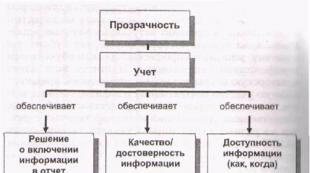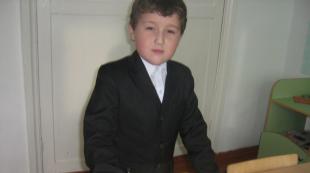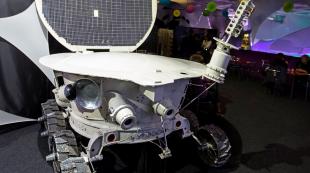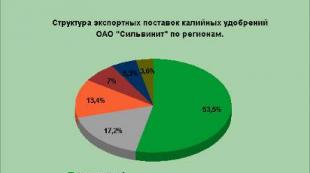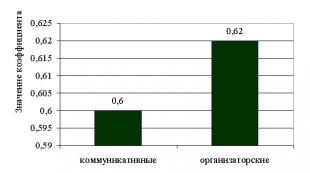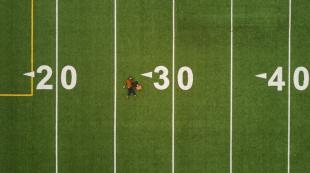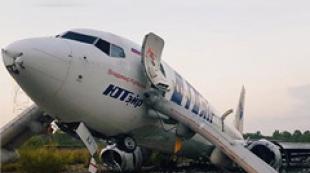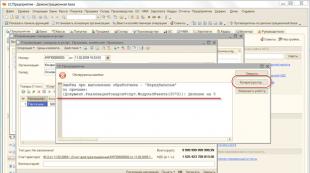Where do snow and ice come from? presentation for a lesson on the world around us (middle group) on the topic. Presentation for the work "Where do snow and ice come from" Where do snow and ice come from presentation
“How snow is formed” - Ice is colorless. Gray geese flew, dropping white fluff. Snowflakes form high in the sky, in the clouds. Do you make ice at home? The first snowflakes are spinning in the air, They will fall to the ground, but will not lie still. It lies quietly all winter, and in the spring it will run away. Let's study the properties of snow and ice. Do you remember what shape of snowflakes fell on your mittens during a walk?
“Where do snow and ice come from” - The water cycle in nature. Properties of ice. Where does ice form? The snow is loose. How ice is formed. In warm weather, snow and ice melt. Snow and ice are formed from water, snow and ice are frozen water. Where do snow and ice come from? The snow is opaque. Properties of ice and snow. Natural phenomena characteristic of winter. Snow is white.
“Rime snow rain dew” - Refers to continuous precipitation falling on the earth's surface. Origin of dew. Snow. Dew. Snow formation. The main water crystal has the shape of a regular hexagon in the plane. Snow is a form of precipitation consisting of small ice crystals. How dew, frost, rain and snow are formed.
“States of Water” - Where water is found. The water cycle in nature. “Drowning or not drowning.” What kind of water is there? Oceans, seas and rivers are filled with water. In the cold, water particles move more slowly, so the water turns into ice. Water vapor A lot of water goes into production. Properties of water. Water pushes out lighter objects.
“Water cycle” - Keyword: water cycle. Who's the Commander? Academician A.P. Karpinsky called water “the most precious fossil.” Crossword. 13 It does not burn in fire and does not drown in water. 14 Who is the Great Laver, the Chief of the Lavers? The sky reflects, the Earth decorates. The water cycle in nature. At a depth of up to 1 km, more than 4 million cubic kilometers of water are stored in the earth's crust.
“Water is a natural phenomenon” - The water cycle in nature. Crossword. Questions for the crossword. Conclusions. Hydroelectric power station. Without water, life is impossible. Land. Have you heard about water? If the water cycle disappeared. Stages of the cycle.
There are a total of 17 presentations in the topic
MKOU "Yeltsovskaya secondary school"
Troitsky district of Altai Territory
“Where do snow and ice come from?”
research work
Head: Shatilova E. A.,
primary school teacher
Eltsovka-2013
Table of contents
Introduction……………………………………………………………..3
Literature review……………………………………………………..4
Location of the study……………………………………………………….5
Research methodology………………………………………………………..5
Research results………………………………………………………6
4.1 Study of the properties of ice and snow…………………….6-7
4. 2. Study of snow……………………………………………8
4.3.Study of the taste qualities of ice and snow…………………………..8
4.4. Determining the significance of snow and ice in the life of nature and humans..9
Conclusions………………………………………………………………………………….10
Introduction
People have long been interested in the following questions:
- Why is it raining?
- Why does the sun shine?
- Why does day follow night?
-Where does snow come from?
These questions began to worry me too.
With the arrival of winter, the temperature dropped. Snow on trees, fields, roofs of houses. The water in the reservoirs froze. Ice bound rivers, lakes, and ponds. Snow and ice are the most striking signs of winter.
I was interested in the question, what properties do snow and ice have?
Target:
Prove that ice and snow are natural phenomena.
In accordance with the problem, subject and purpose of the study, the following were set:tasks:
1. Get to know the properties of snow and ice.
2. Identify similarities and differences.
3. Study literature that talks about the benefits of snow and ice.
Proposing a hypothesis.
Is it possible to assume that snow and ice are the same thing?
During the work we usedmethods:
Studying natural history literature on this topic;
Research, observations;
Analysis of the obtained results by comparison.
Object of study - snow and ice.
Subject of study - properties of snow and ice
1.Literature review
When there is a lot of snow in winter, it’s wonderful! The air becomes clean, because snowflakes clear it of dust and dirt. It is very beneficial to breathe clean air. The number of diseases decreases. If the winter is snowy, in the spring the earth will drink its fill of moisture. Snow promises us a harvest. No wonder they say: “A lot of snow means a lot of bread.” Snow is needed to protect crops from the cold. Under the snow there is almost never more than two degrees of frost. In spring, the snow will melt and fill the ground with moisture. During severe frosty winters, many birds hide in the snow: black grouse, hazel grouse, partridges, wood grouse. Mice are hiding under the snow. A bear and a badger hibernate. A hare takes refuge in the snow in bad weather. At the bottom of deep reservoirs in winter the temperature is not lower than 4 degrees. The ice roof reliably protects from the cold.
When the air temperature drops below 0°, the water on the soil surface freezes and turns into ice. The ice surface is smooth and slippery. Ice is a dangerous inanimate phenomenon for people. You can slip and fall and get injured. The knowledge that ice is slippery helped in ancient times in the fight against enemies. Fortresses, as a rule, were protected from enemies by moats with water. In winter, when the enemy approached the fortress, the defenders poured water on the walls of the fortress. It was impossible to climb up the ice wall.
Ice is a solid. This property of ice is used by humans. People use this property of ice to move across frozen bodies of water in winter by transport and on foot. This is especially important in places far from railways, where powerful trucks carry cargo along icy roads. The properties of ice as a solid are also used in stadiums and schoolyards, where in winter large ice skating rinks are poured for sports.
Snow and ice are fun for kids and adults.
2. Location of the study
Work began in December 2013. The research was carried out at the Municipal Educational Institution “Yeltsov Secondary School”.
3. Research methodology
When conducting research, we used the methodology from the textbook “The World Around us”, grade 1 (5), and the methodology from the methodological manual on the world around us. (7)
Snow and ice were taken for the study. A wooden stick was used to determine looseness. To determine color - colored paper.
4. Research results
4.1 Study of the properties of ice and snow
Experience No. 1
To find out the properties of snow and ice, I took a lump of snow. I made a hole with a stick. But I couldn’t pierce the ice with a stick. Then I took a hammer and hit a piece of ice. The ice cracked and crumbled.
The results of the study showed that the snow is soft and loose. Ice is hard and brittle.
This experience showed that snow and ice are different from each other. (Annex 1)
Experience No. 2
In order to determine the color of the snow, I put a lump of snow and a piece of ice on a sheet of colored paper. Comparing snow and ice by color. Snow is white and ice is colorless.
I tried to see the color of the paper through the snow and ice. The color is not visible through the snow, but through the ice it is visible. The results of the study showed: snow is white, ice is colorless. Snow is opaque, ice is transparent. (Appendix 2)
Why? It turns out that snow cannot transmit the entire ray of sunlight through itself and reflects the purest color of a white ray of sunlight. But ice transmits the sun's rays and remains colorless.
These properties make a snowflake and a piece of ice different.
Experience No. 3
I was interested to know what snow and ice are made of. For this I took 2 glasses. I put snow in one glass and ice in the other. The snow melted faster than the ice.
If water from melting snow and ice is placed in the freezer, the water will freeze again.
Snow and ice are made of water. The snow is melting quickly. Ice slowly. (Appendix 3)
And the water from the snow and ice froze in the refrigerator.
Experience No. 4
I put snow and ice in a container of water. And do you know what I saw? Neither snow nor ice sank, but remained on the surface of the water. This means that snow and ice are lighter than water. (Appendix 4)
Thus, I refuted the hypothesis. Snow and ice are not the same thing.
Although their properties are different, snow and ice are frozen water.
4. 2. Snow research
In order to find out whether the snow is pure or not, I put a lump of snow in a glass. When the snow melted, a dark sediment appeared at the bottom of the glass. Through several layers of gauze, the melt water was poured into a clean glass. There is dirt left on the gauze.
Observing the condition of the snow in various places, I found out that the snow in the forest is cleaner than near the roads. (Appendix 5)
4.3. Study of the taste qualities of ice and snow
Mom says that you can’t eat snow and ice, but from books I learned that if you put fruit juice in a container in the freezer, it will freeze and turn into a piece of ice. To make real ice cream, you need to constantly stir the liquid as it freezes. This is the only way to get ice cream, not ice.
I did some research and made ice cubes from water and juice in the freezer. An ice cube made from juice turned out to be much tastier. I tried snow from the freezer - it didn’t taste good. (Appendix 6)
Through research, I realized that snow and ice can only be edible if they are made by a person.
4.4. Determining the significance of snow and ice in the life of nature and humans.
Observation #1
One day, while walking near the house, I dug out the snow with a shovel. And I saw small sprouts of grass. From the textbook “The World Around us” I learned that many animals hibernate in the snow and hide from the cold. This is a mouse, bear, chipmunk, hedgehog, black grouse, wood grouse, hazel grouse. What do fishermen do on the river in winter? They catch fish. Why doesn't every living thing freeze under the ice? It turns out that the temperature under the ice is above zero. It turns out that plants, roots, and seeds need snow. It does not heat, but, like ice, it retains heat.
Snow and ice retain heat, and therefore are of great importance for the life of plants and animals.
Observation #2
Playing snowballs, building snow towns, fortresses, skiing, sledding, skating are winter entertainment for people. From books I learned that in Rus' they rode on ice skates. Ice circles were prepared and a place for a seat was cut out in them. They put straw and hay there. A hole was made in the front of the ice cube for the rope. The ice cube was carefully leveled from below. Our great-grandmothers and great-grandfathers rode on ice like these. Craftsmen make real works of art from ice: ice carriages, palaces, castles.
I also want to say that children love both snow and ice. Because in winter there is a lot of entertainment for children.
Snow and ice are of great importance in human life.
5. Conclusions
As a result of our experiments and observations, we confirmed the initial hypothesis that snow and ice are not the same thing. The similarities and differences between snow and ice were revealed. We found out that snow and ice are of great importance in the life of wildlife and humans.
It is necessary to continue work on studying the properties of snow. During the winter season, stay outside as much as possible.
Conclusion
I discovered a lot of new things by studying literature. He himself participated in experiments and observations.
The work may have practical implications. It can be used in lessons about the surrounding world.
Literature.
1. Biryukova A. Yu. Great schoolchild encyclopedia. - Planet Earth. Publishing house Rosman-Press, 2003.- 657 p.
2. Markin V. A. Children's encyclopedia. "I'm exploring the world." – M.: AST Publishing House LLC, 2001.-557 p.
3. Klepinina Z. A. Textbook “Nature Studies” 2nd grade Moscow “Enlightenment” 1992.- 128 p.
4 . Krivobok E.V. Research activities of junior schoolchildren.-Volgograd: Teacher, 2008.-138 p.
5. Pleshakov A. A., Textbook “The World Around You”. 1st grade Moscow “Enlightenment”, 2011.- 127 p.
6. Trafimova G.V., Trafimov S.A., Textbook “The world around us” 1st grade Moscow “Akademkniga”, 2008.-79 p.
7. Trafimova G.V., Trafimov S.A., Methodological manual on the surrounding world, 1st grade, Moscow “Akademkniga”, 2007.-104 p.
8. Feoktistova V. F. Research and project activities of junior schoolchildren. - Volgograd: Teacher, 2008. - 142 p.
Annex 1
Photo 1

Photo 2

Photo 3
Appendix 2

Photo 4
Appendix 3


Photo 5
Photo 6
Appendix 4

Photo 6
Appendix 5


Photo 7
Photo 8
Appendix 6

Photo 9


Photo 10
Photo 11


Photo 12 Photo 13
To use presentation previews, create a Google account and log in to it: https://accounts.google.com
Slide captions:
The world around us Where do snow and ice come from?
Winter in the forest. Frost. I.I.Shishkin Winter
It lies quietly all winter, and in the spring it will run away. Not a precious stone, but glittering.
Gray geese flew, dropping white fluff. Grandfather builds a bridge without an axe.
Where do snow and ice come from?
Guys! Let's study the properties of snow and ice.
Snow is white. Ice is colorless.
The snow is opaque. The ice is transparent.
The snow is loose. Ice is fragile.
In warm weather, snow and ice melt. Water is formed.
Snow and ice are formed from water, snow and ice are frozen water.
The sun warms the earth weakly, The frost crackles at night, In the snow woman's yard, her carrot nose has turned white. The water in the river suddenly became motionless and hard. The blizzard is angry, the snow is spinning, sweeping everything around with snow-white silver.
Where does snow form?
A cloud walked across the sky and accidentally dozed off. Violent winds in the wild We saw: a cloud is sleeping, And from there fluff flies... The fluff flies - It ripples in the eyes, And if you catch it, it's cold.
Snowflakes form high in the sky, in the clouds.
Where does ice form? Can we make our own ice? How? Do you make ice at home? For what?
Do you remember what shape of snowflakes fell on your mittens during a walk? They were all different and very beautiful, but they always had six rays, six needles.
The first snowflakes are spinning in the air, They will fall to the ground, but will not lie still. The first snowflakes on your hand will melt... They chill, excite and remind you that winter days are about to come, that it’s time to prepare skis and skates, that it’s time to prepare sleds for the kids. And make a skating rink and a slide in the yard... The first snowflakes - hello from winter, As if checking whether you are waiting or not.
We made a snowball. The ears were made later. And just instead of eyes, we found Coals. The rabbit came out alive! He has a tail and a head! Don't pull your mustache - they're made from straws! Long, shiny, exactly real!
